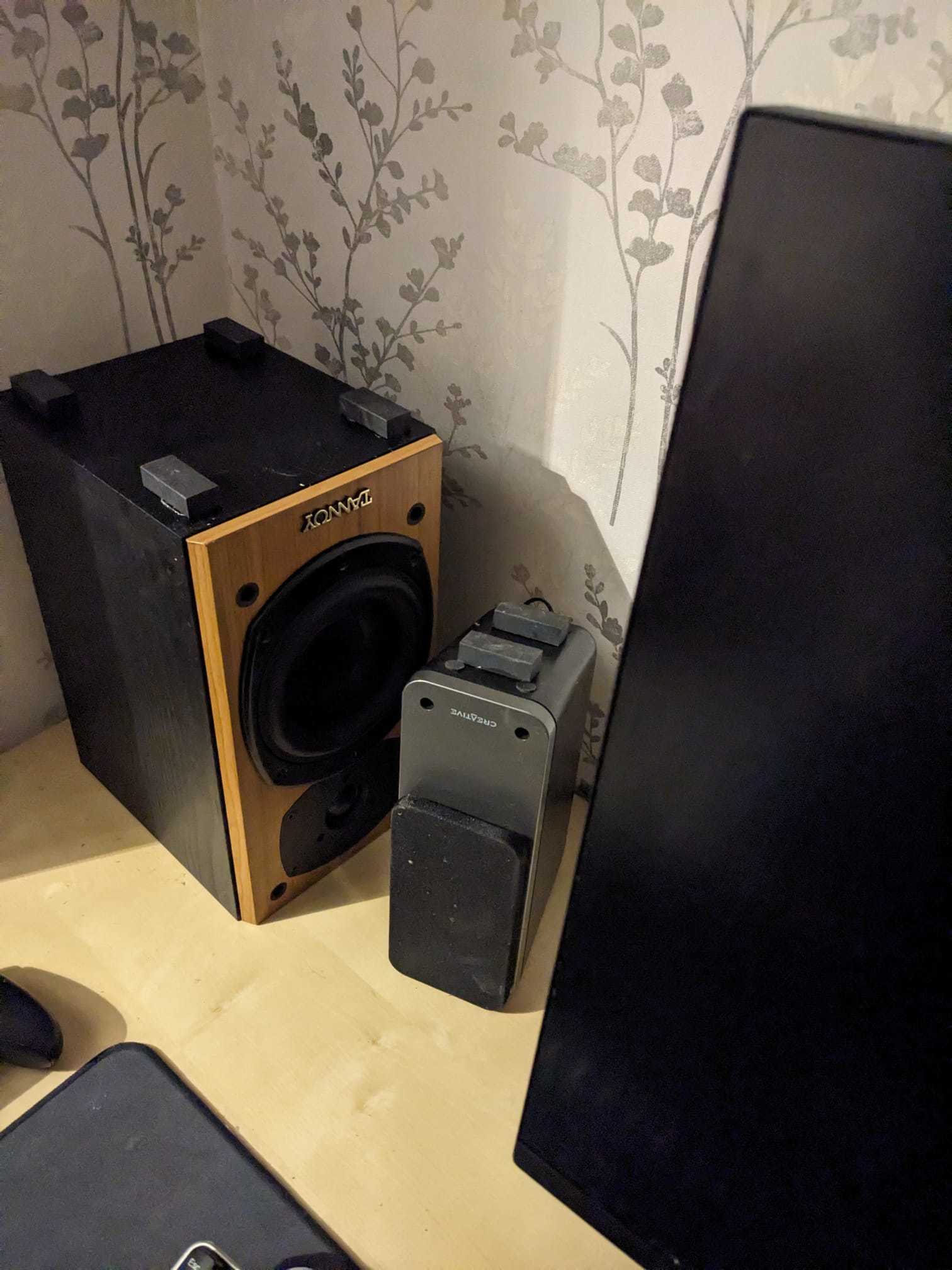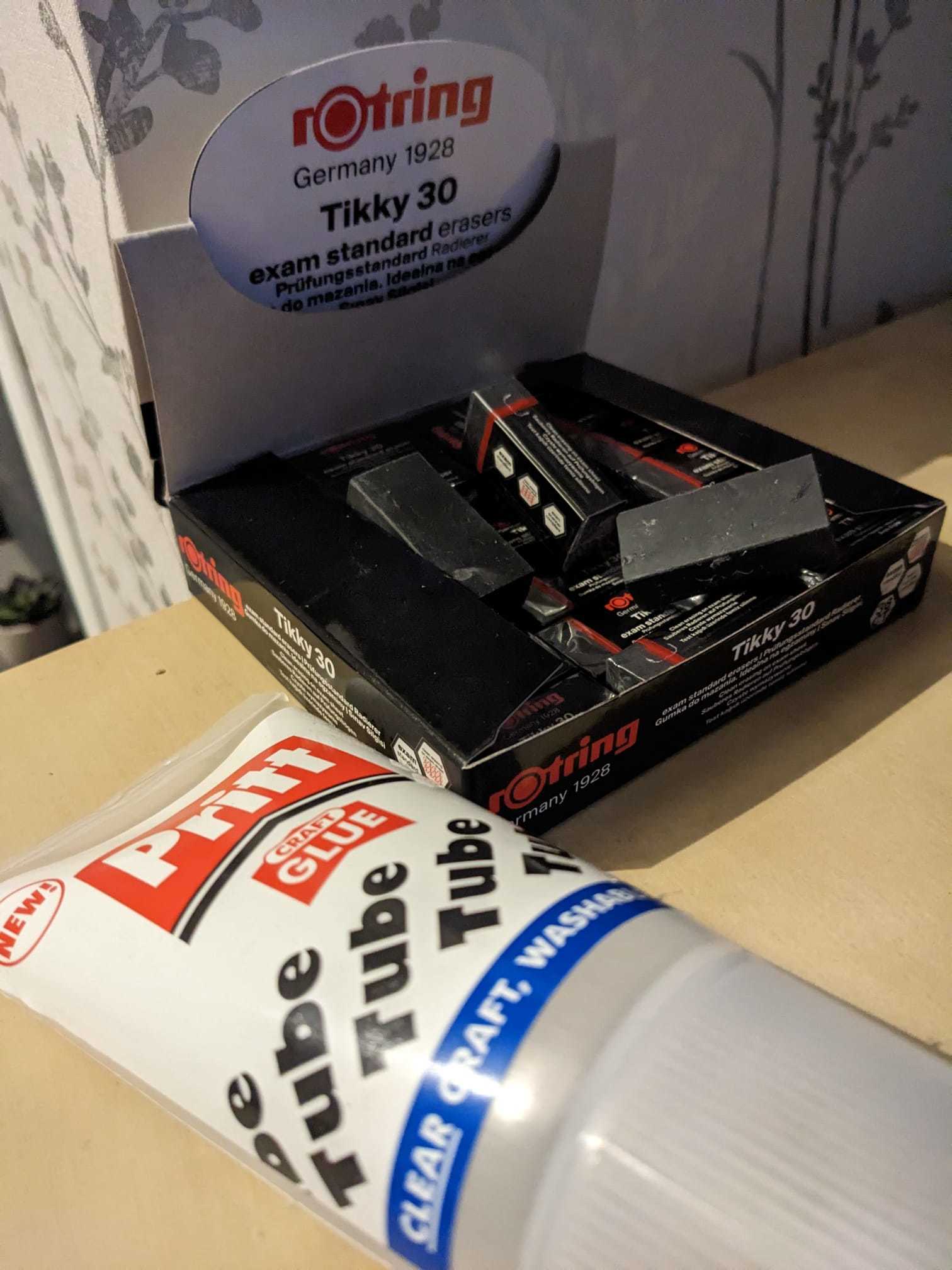Hi guys I've been told that putting isolation pads under my bookshelf speakers will improve sound quality they are currently sitting on the small silicone feet that came with. The speakers are monitor audio silver 50 7g radius 200 and radius 90s. Is there any truth in this and if so what would you recommend
You are using an out of date browser. It may not display this or other websites correctly.
You should upgrade or use an alternative browser.
You should upgrade or use an alternative browser.
Isolation pads
- Thread starter arix
- Start date
More options
Thread starter's postsSoldato
- Joined
- 6 Sep 2016
- Posts
- 13,714
yup and use speaker stands. Blutack to stands, and at ear height.
Soldato
- Joined
- 6 Sep 2016
- Posts
- 13,714
Desktop speaker stands to raise them ear level
or even a bunch or rubber pencil erasers... cut to size/angle if needed with a craft knife/stanley knife to make better feet.
Something like this maybe...
Something like this maybe...
Last edited:
This is about managing the energy - the vibrations - going from the speaker into the surface they're sitting on. If there's enough energy, then the shelf becomes a sort of speaker as it vibrates along with the speaker that's energising it.
Various materials have different properties depending on frequency. Some weird things can happen. Some of the weirdest are non-Newtonian liquids. Depending on how they're handled they can turn from liquid to solid and back. LINK. On the same vein, a material that feels slightly squashy pressed between the fingers can exhibit different properties - becoming almost solid - at much higher frequencies. The little silicon rubber feet might be a case in point.
Speaker isolation is a common topic for home- and studio- recording/mixing. Foam wedges can be used to both isolate and angle a speaker. These might not be exactly what you're looking for, but they're inexpensive and a start. LINK. There are, of course, the Hi-Fi industry's solutions such as IsoAcoustics pucks. They're pricey, and the results can depend on a lot of other factors.
I would start with searching YouTube for videos of tests where someone has used a calibrated mic to plot the before and after results. Or at least find web sites that have done the same. What you're looking to see is a much cleaner frequency sweep and a waterfall plot that shows much quicker energy decay. If you can find 2 or 3 or 4 independent tests that all come to similar conclusions then that's likely to be a product worth investigating.
Various materials have different properties depending on frequency. Some weird things can happen. Some of the weirdest are non-Newtonian liquids. Depending on how they're handled they can turn from liquid to solid and back. LINK. On the same vein, a material that feels slightly squashy pressed between the fingers can exhibit different properties - becoming almost solid - at much higher frequencies. The little silicon rubber feet might be a case in point.
Speaker isolation is a common topic for home- and studio- recording/mixing. Foam wedges can be used to both isolate and angle a speaker. These might not be exactly what you're looking for, but they're inexpensive and a start. LINK. There are, of course, the Hi-Fi industry's solutions such as IsoAcoustics pucks. They're pricey, and the results can depend on a lot of other factors.
I would start with searching YouTube for videos of tests where someone has used a calibrated mic to plot the before and after results. Or at least find web sites that have done the same. What you're looking to see is a much cleaner frequency sweep and a waterfall plot that shows much quicker energy decay. If you can find 2 or 3 or 4 independent tests that all come to similar conclusions then that's likely to be a product worth investigating.
What are your thoughts regarding these https://www.av.com/Accessories/Fisu...b2B8Jl4Kejc2-vVLATnyPt7709ust0axoCiroQAvD_BwE
a few people have mentioned them
a few people have mentioned them
Probably OK for an experiment, but for £7 I decided to put my money where my mouth is and bought a bulk pack of Rotring black pencil rubbers.
The glue is still drying so I can't comment on performance difference yet.
I've added them to my oldskool t20 pc speakers, and my tannoy M1 bookshelf speakers which I use for the TV, and listening to music.
Worst case scenario I'm now the proud owner of a lifetime supply of pencil erasers, lol!
I figured it can't hurt to try as my speakers are sat on a dask with no sound isolation at all.


The glue is still drying so I can't comment on performance difference yet.
I've added them to my oldskool t20 pc speakers, and my tannoy M1 bookshelf speakers which I use for the TV, and listening to music.
Worst case scenario I'm now the proud owner of a lifetime supply of pencil erasers, lol!
I figured it can't hurt to try as my speakers are sat on a dask with no sound isolation at all.


Last edited:
At a couple of quid a piece for a pack of 8 they're hardly going to break the bank. Try them. I think they'll be better than the silicon dots because they're more compliant. They're probably going to be a bit big though for the Radius 90s. See what you think.What are your thoughts regarding these https://www.av.com/Accessories/Fisu...b2B8Jl4Kejc2-vVLATnyPt7709ust0axoCiroQAvD_BwE
a few people have mentioned them
Do the Silver 50s first. Run an A:B comparison by using some £1 coins stacked to couple the speakers directly to the shelf and then swap over to the feet, then back and forth a few time. Let us know what you think. {Oh, for the coins, just use 3 stacks per speaker so that balance isn't an issue.]
Last edited:
Thanks guys iam possibly going to give these a go any used them https://www.amazon.co.uk/Monitor-Sp...9zZWFyY2hfYXRm&psc=1&smid=A38AYWK6FYFHZ7&th=1
After my DIY experiment I can confirm that I now have more chrystal treble and less bass boom.
It maybe a placeabo effect, but it certainly doesn't sound worse.
So I'm going to leave the black rubber pencil erasers on my speakers, as feet, in Lieu of expensive isolation pads.
It maybe a placeabo effect, but it certainly doesn't sound worse.
So I'm going to leave the black rubber pencil erasers on my speakers, as feet, in Lieu of expensive isolation pads.
Last edited:
After my DIY experiment I can confirm that I now have more chrystal treble and less bass boom.
It maybe a placeabo effect, but it certainly doesn't sound worse.
So I'm going to leave the black rubber pencil erasers on my speakers, as feet, in Lieu of expensive isolation pads.
Or less bass vibration on the desk thus erased bass means more noted treble?

